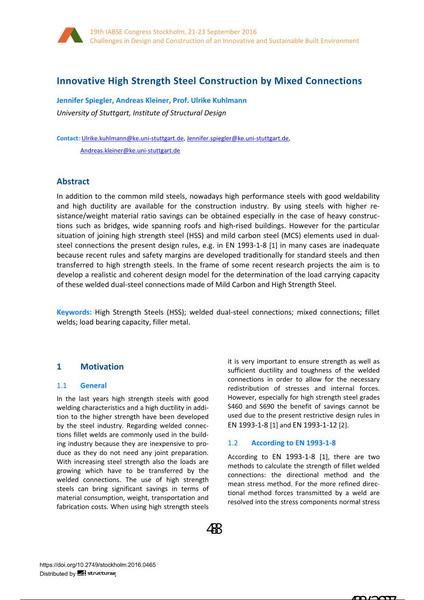Innovative High Strength Steel Construction by Mixed Connections

|
|
|||||||||||
Bibliografische Angaben
| Autor(en): |
Jennifer Spiegler
(University of Stuttgart, Institute of Structural Design)
Andreas Kleiner (University of Stuttgart, Institute of Structural Design) Ulrike Kuhlmann (University of Stuttgart, Institute of Structural Design) |
||||
|---|---|---|---|---|---|
| Medium: | Tagungsbeitrag | ||||
| Sprache(n): | Englisch | ||||
| Tagung: | IABSE Congress: Challenges in Design and Construction of an Innovative and Sustainable Built Environment, Stockholm, Sweden, 21-23 September 2016 | ||||
| Veröffentlicht in: | IABSE Congress Stockholm, 2016 | ||||
|
|||||
| Seite(n): | 488-495 | ||||
| Anzahl der Seiten (im PDF): | 8 | ||||
| Jahr: | 2016 | ||||
| DOI: | 10.2749/stockholm.2016.0465 | ||||
| Abstrakt: |
In addition to the common mild steels, nowadays high performance steels with good weldability and high ductility are available for the construction industry. By using steels with higher re- sistance/weight material ratio savings can be obtained especially in the case of heavy construc- tions such as bridges, wide spanning roofs and high-rised buildings. However for the particular situation of joining high strength steel (HSS) and mild carbon steel (MCS) elements used in dual- steel connections the present design rules, e.g. in EN 1993-1-8 [1] in many cases are inadequate because recent rules and safety margins are developed traditionally for standard steels and then transferred to high strength steels. In the frame of some recent research projects the aim is to develop a realistic and coherent design model for the determination of the load carrying capacity of these welded dual-steel connections made of Mild Carbon and High Strength Steel. |
||||
